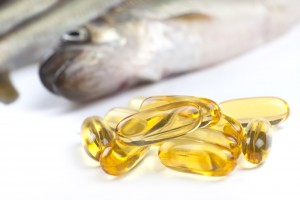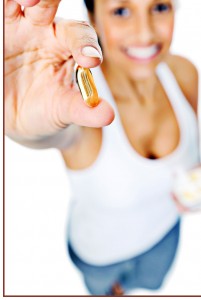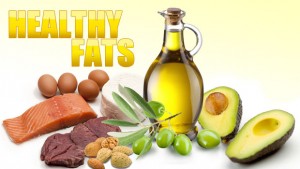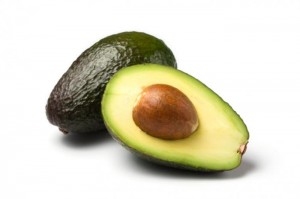Most supplements are used for one specific outcome, for example fat loss, muscle growth or general health promotion. However, there are a few exceptions. Fish oil is one of them.
We all know about the cardiovascular health benefits of fish oil, and in a previous article I covered the fat loss effect of fish oil. Now let’s take a look at the potential application of fish oil for those of us who are interested in muscle growth…
Anti-catabolic effects of fish oil
Muscle protein undergoes a continuous process of synthesis (anabolism) and degradation (catabolism). In a healthy state, the anabolic and catabolic processes are balanced to maintain stability of or even increase muscle mass (as is observed with resistance training combined with proper nutrition).
Catabolism of muscle tissue is common in both clinical states (for example diabetes, renal failure, trauma and cancer) and during diet-induced weight loss and other stress conditions 1-6. During these catabolic states, muscle protein degradation exceeds muscle protein synthesis, which results in muscle loss and weakness.
Muscle protein catabolism is primarily caused by the ubiquitin-proteasome system 36-11. It is here fish oil enters the picture, since its fatty acid EPA significantly decreases the activity of the muscle protein catabolic (ubiquitin-proteasome) system 24512-16.
Another mechanism by which fish oil exerts its anti-catabolic effect is by reducing cortisol levels 1718. As we all know, cortisol breaks down muscle tissue 19 and has a host of other detrimental effects when present at chronically elevated levels (which is a topic in its own right), so this is a beneficial effect of fish oil beyond anti-catabolism.
What makes fish oil especially interesting is that it seems to promote muscle growth by not only inhibiting muscle catabolism, but also by stimulating muscle anabolism. Recent studies showed that supplementing for 8 weeks with 4 g per day of fish oil concentrate providing a daily dose of 1.86 g EPA and 1.5 g DHA, significantly increases the anabolic response of muscle protein synthesis to amino acids and insulin 20. The augmented anabolic response to amino acids and insulin was shown to be due to an increased activation of the mTOR/p70S6K signalling pathway, which is considered an integral control point for muscle protein anabolism 21 and muscle cell growth 22-25.
Other mechanisms probably contribute as well. The same study showed that the fish oil supplementation in 25-45 year old healthy subjects doubled the proportion of EPA, DPA (another less talked about omega-3 fatty acid) and DHA in muscle cell membranes, at the expense of omega-6 fatty acids and mono-unsaturated fatty acids, with no change in saturated fatty acid) concentrations 20. Thus, it is also possible that fish oil supplementation influences anabolic signalling cascades by affecting membrane lipid composition and/or fluidity 26-29.
Are you older than 45 yr? Don’t fret, you will still benefit from the muscle anabolic effects of fish oil. The same research team conducted another study, using an identical research protocol (1.86 g EPA and 1.5 g DHA for 8 weeks), in healthy elderly subjects over 65 years (mean age 71 years). The results were the same as in the younger subjects; the fish oil supplementation significantly increased the muscle protein synthetic response to amino acids and insulin 30. Thus, fish oil seems to attenuate the anabolic resistance associated with old age 31-33. The researchers were so impressed with the response that they concluded fish oil can be useful for both prevention and treatment of sarcopenia 30.
In both of these studies, muscle mass was not measured because the interventions only lasted for 8 weeks. However, taking into consideration that changes in muscle protein metabolism precede corresponding changes in muscle mass 34-36, these results are promising. It is going to be interesting to see longer term studies that measure actual fish oil induced gains in muscle mass, and also how the anabolic response to fish oil interacts with resistance training.
Wrap up
Whether you’re looking to build muscle or prevent loss of muscle during a diet, evidence supports the addition of fish oil to your supplement regimen. Fish oil, and especially EPA, not only counteracts the detrimental loss of muscle mass that we see in stressful and catabolic states, but also boosts the anabolic response to nutritional stimuli in healthy muscle from both young, middle-age and older adults. Thus, it beneficially affects both the catabolic and anabolic sides of the muscle protein balance equation.
The studies to date used a fish oil dose corresponding to 1.86 g EPA and 1.5 g DHA (which can be considered to be a medium high dose). We don’t know yet if a higher or lower dose would have a greater/smaller effect, but this dose is a good guideline to start with.
References:
1. Bailey JL, Wang X, Price SR. The balance between glucocorticoids and insulin regulates muscle proteolysis via the ubiquitin-proteasome pathway. Miner Electrolyte Metab 1999;25(4-6):220-3.
2. Ross JA, Moses AG, Fearon KC. The anti-catabolic effects of n-3 fatty acids. Current opinion in clinical nutrition and metabolic care 1999;2(3):219-26.
3. Ventadour S, Attaix D. Mechanisms of skeletal muscle atrophy. Curr Opin Rheumatol 2006;18(6):631-5.
4. Whitehouse AS, Smith HJ, Drake JL, Tisdale MJ. Mechanism of attenuation of skeletal muscle protein catabolism in cancer cachexia by eicosapentaenoic acid. Cancer Res 2001;61(9):3604-9.
5. Whitehouse AS, Tisdale MJ. Downregulation of ubiquitin-dependent proteolysis by eicosapentaenoic acid in acute starvation. Biochemical and biophysical research communications 2001;285(3):598-602.
6. Wing SS, Goldberg AL. Glucocorticoids activate the ATP-ubiquitin-dependent proteolytic system in skeletal muscle during fasting. The American journal of physiology 1993;264(4 Pt 1):E668-76.
7. Attaix D, Aurousseau E, Combaret L, Kee A, Larbaud D, Ralliere C, et al. Ubiquitin-proteasome-dependent proteolysis in skeletal muscle. Reprod Nutr Dev 1998;38(2):153-65.
8. Attaix D, Ventadour S, Codran A, Bechet D, Taillandier D, Combaret L. The ubiquitin-proteasome system and skeletal muscle wasting. Essays Biochem 2005;41:173-86.
9. Jagoe RT, Goldberg AL. What do we really know about the ubiquitin-proteasome pathway in muscle atrophy? Current opinion in clinical nutrition and metabolic care 2001;4(3):183-90.
10. Mitch WE, Goldberg AL. Mechanisms of muscle wasting. The role of the ubiquitin-proteasome pathway. The New England journal of medicine 1996;335(25):1897-905.
11. Tisdale MJ. The ubiquitin-proteasome pathway as a therapeutic target for muscle wasting. J Support Oncol 2005;3(3):209-17.
12. Fearon KC, Von Meyenfeldt MF, Moses AG, Van Geenen R, Roy A, Gouma DJ, et al. Effect of a protein and energy dense N-3 fatty acid enriched oral supplement on loss of weight and lean tissue in cancer cachexia: a randomised double blind trial. Gut 2003;52(10):1479-86.
13. Smith HJ, Greenberg NA, Tisdale MJ. Effect of eicosapentaenoic acid, protein and amino acids on protein synthesis and degradation in skeletal muscle of cachectic mice. British journal of cancer 2004;91(2):408-12.
14. Smith HJ, Khal J, Tisdale MJ. Downregulation of ubiquitin-dependent protein degradation in murine myotubes during hyperthermia by eicosapentaenoic acid. Biochemical and biophysical research communications 2005;332(1):83-8.
15. Smith HJ, Lorite MJ, Tisdale MJ. Effect of a cancer cachectic factor on protein synthesis/degradation in murine C2C12 myoblasts: modulation by eicosapentaenoic acid. Cancer Res 1999;59(21):5507-13.
16. Smith HJ, Tisdale MJ. Induction of apoptosis by a cachectic-factor in murine myotubes and inhibition by eicosapentaenoic acid. Apoptosis 2003;8(2):161-9.
17. Delarue J, Matzinger O, Binnert C, Schneiter P, Chiolero R, Tappy L. Fish oil prevents the adrenal activation elicited by mental stress in healthy men. Diabetes & metabolism 2003;29(3):289-95.
18. Noreen EE, Sass MJ, Crowe ML, Pabon VA, Brandauer J, Averill LK. Effects of supplemental fish oil on resting metabolic rate, body composition, and salivary cortisol in healthy adults. Journal of the International Society of Sports Nutrition 2010;7:31.
19. Rooyackers OE, Nair KS. Hormonal regulation of human muscle protein metabolism. Annual review of nutrition 1997;17:457-85.
20. Smith GI, Atherton P, Reeds DN, Mohammed BS, Rankin D, Rennie MJ, et al. Omega-3 polyunsaturated fatty acids augment the muscle protein anabolic response to hyperinsulinaemia-hyperaminoacidaemia in healthy young and middle-aged men and women. Clin Sci (Lond) 2011;121(6):267-78.
21. Drummond MJ, Fry CS, Glynn EL, Dreyer HC, Dhanani S, Timmerman KL, et al. Rapamycin administration in humans blocks the contraction-induced increase in skeletal muscle protein synthesis. The Journal of physiology 2009;587(Pt 7):1535-46.
22. Bodine SC, Stitt TN, Gonzalez M, Kline WO, Stover GL, Bauerlein R, et al. Akt/mTOR pathway is a crucial regulator of skeletal muscle hypertrophy and can prevent muscle atrophy in vivo. Nature cell biology 2001;3(11):1014-9.
23. Rommel C, Bodine SC, Clarke BA, Rossman R, Nunez L, Stitt TN, et al. Mediation of IGF-1-induced skeletal myotube hypertrophy by PI(3)K/Akt/mTOR and PI(3)K/Akt/GSK3 pathways. Nature cell biology 2001;3(11):1009-13.
24. Baar K, Esser K. Phosphorylation of p70(S6k) correlates with increased skeletal muscle mass following resistance exercise. The American journal of physiology 1999;276(1 Pt 1):C120-7.
25. O’Neil TK, Duffy LR, Frey JW, Hornberger TA. The role of phosphoinositide 3-kinase and phosphatidic acid in the regulation of mammalian target of rapamycin following eccentric contractions. The Journal of physiology 2009;587(Pt 14):3691-701.
26. Mansilla MC, Banchio CE, de Mendoza D. Signalling pathways controlling fatty acid desaturation. Sub-cellular biochemistry 2008;49:71-99.
27. Stillwell W, Wassall SR. Docosahexaenoic acid: membrane properties of a unique fatty acid. Chemistry and physics of lipids 2003;126(1):1-27.
28. Armstrong VT, Brzustowicz MR, Wassall SR, Jenski LJ, Stillwell W. Rapid flip-flop in polyunsaturated (docosahexaenoate) phospholipid membranes. Archives of biochemistry and biophysics 2003;414(1):74-82.
29. Stillwell W, Shaikh SR, Zerouga M, Siddiqui R, Wassall SR. Docosahexaenoic acid affects cell signaling by altering lipid rafts. Reprod Nutr Dev 2005;45(5):559-79.
30. Smith GI, Atherton P, Reeds DN, Mohammed BS, Rankin D, Rennie MJ, et al. Dietary omega-3 fatty acid supplementation increases the rate of muscle protein synthesis in older adults: a randomized controlled trial. The American journal of clinical nutrition 2011;93(2):402-12.
31. Cuthbertson D, Smith K, Babraj J, Leese G, Waddell T, Atherton P, et al. Anabolic signaling deficits underlie amino acid resistance of wasting, aging muscle. The FASEB journal : official publication of the Federation of American Societies for Experimental Biology 2005;19(3):422-4.
32. Guillet C, Prod’homme M, Balage M, Gachon P, Giraudet C, Morin L, et al. Impaired anabolic response of muscle protein synthesis is associated with S6K1 dysregulation in elderly humans. The FASEB journal : official publication of the Federation of American Societies for Experimental Biology 2004;18(13):1586-7.
33. Rasmussen BB, Fujita S, Wolfe RR, Mittendorfer B, Roy M, Rowe VL, et al. Insulin resistance of muscle protein metabolism in aging. The FASEB journal : official publication of the Federation of American Societies for Experimental Biology 2006;20(6):768-9.
34. Hawley JA, Tipton KD, Millard-Stafford ML. Promoting training adaptations through nutritional interventions. Journal of sports sciences 2006;24(7):709-21.
35. Hawley JA, Burke LM, Phillips SM, Spriet LL. Nutritional modulation of training-induced skeletal muscle adaptations. J Appl Physiol 2011;110(3):834-45.
36. Rennie MJ, Wackerhage H, Spangenburg EE, Booth FW. Control of the size of the human muscle mass. Annual review of physiology 2004;66:799-828.
About the Author
Monica Mollica
Health Journalist, Nutrition / Diet Consultant & Personal Trainer
BSc and MSc in Nutrition from the University of Stockholm
ISSA Certified Personal Trainer
Website: www.trainergize.com
Email: monica@trainergize.com





